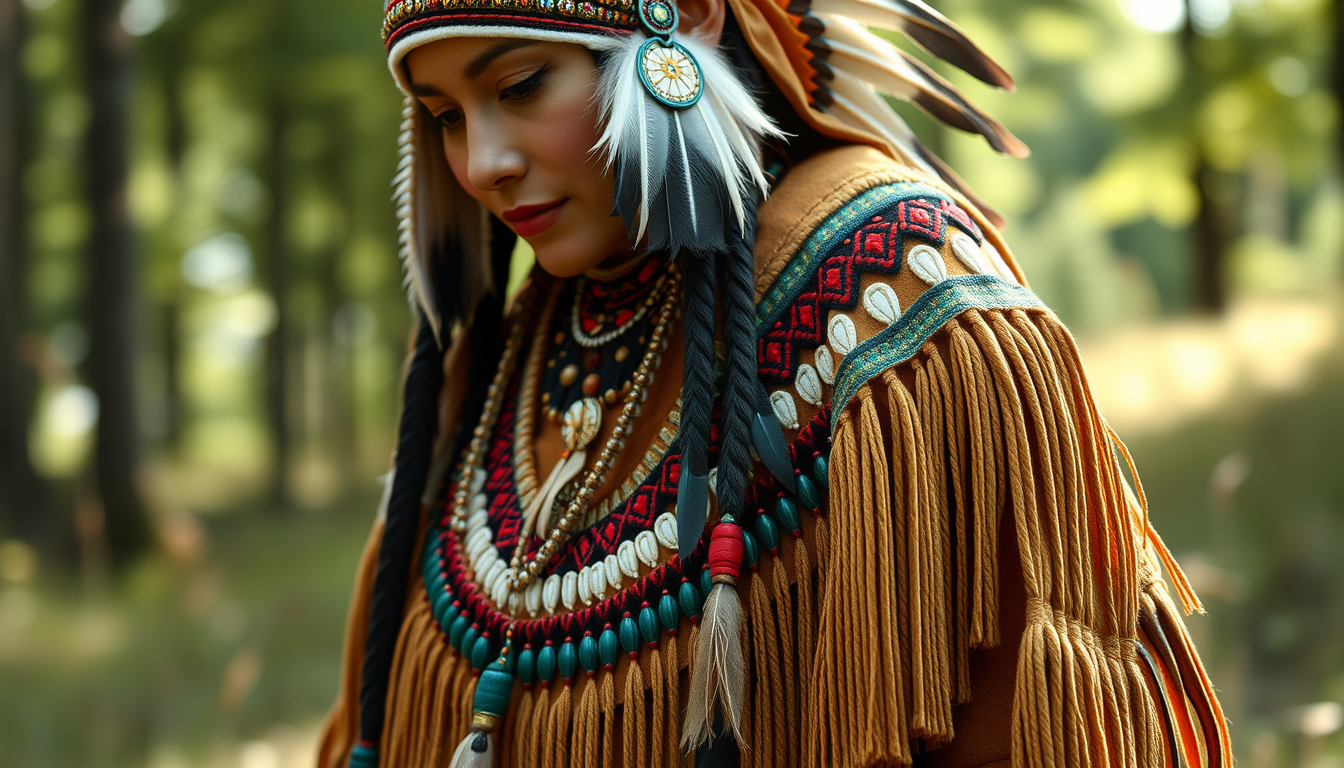American Indian outfits are a rich tapestry of history, culture, and tradition. These garments are not just clothing; they are a reflection of the unique identity and heritage of various Native American tribes. This comprehensive guide will delve into the intricacies of American Indian outfits, exploring their history, significance, and the various elements that make them distinct.
The Historical Context
The history of American Indian outfits is deeply rooted in the pre-colonial era. Before the arrival of European settlers, Native Americans had developed a sophisticated system of clothing that was both functional and aesthetically pleasing. The materials used in these outfits were primarily sourced from nature, including animal hides, plant fibers, and natural dyes.
Pre-Colonial Era
In the pre-colonial era, Native American tribes utilized a variety of materials to create their clothing. For instance, the Plains Indians used buffalo hides to make robes and moccasins, while the Northwest Coast tribes were known for their intricate cedar bark clothing. The materials and designs often reflected the tribe’s environment and cultural beliefs.
Influence of European Settlers
The arrival of European settlers brought significant changes to Native American clothing. The introduction of new materials like wool and cotton, as well as new techniques and styles, altered the traditional methods of clothing production. However, many tribes continued to incorporate traditional elements into their outfits, creating a unique blend of old and new.
Cultural Significance
American Indian outfits hold deep cultural significance for the tribes that wear them. They are often worn during ceremonies, powwows, and other important cultural events. The clothing is not just a piece of clothing; it is a symbol of identity, heritage, and cultural pride.
Symbolism and Meaning
The symbols and designs on American Indian outfits often hold specific meanings. For example, the eagle feathers in many outfits represent courage and wisdom, while the colors used can signify different aspects of the tribe’s beliefs and history. Each element of the outfit is carefully chosen to convey a specific message or story.
Ceremonial Wear
Ceremonial wear is a significant part of American Indian outfits. These outfits are often worn during important rituals and ceremonies, such as the Sun Dance or the Green Corn Dance. The clothing is designed to be both functional and symbolic, reflecting the tribe’s spiritual beliefs and cultural practices.
Traditional Elements
American Indian outfits are characterized by several traditional elements that set them apart from other forms of clothing. These elements include specific materials, designs, and techniques.
Materials
The materials used in American Indian outfits are often sourced from nature. Animal hides, such as buffalo, deer, and elk, are commonly used for robes and moccasins. Plant fibers, like cotton and flax, are used for clothing and accessories. Natural dyes, derived from plants and minerals, are used to color the materials.
Designs
The designs on American Indian outfits are often intricate and symbolic. They can include geometric patterns, animal motifs, and abstract shapes. These designs are not just aesthetically pleasing; they often hold specific meanings and represent the tribe’s history and beliefs.
Techniques
The techniques used to create American Indian outfits are often passed down through generations. These techniques include beading, quilling, and embroidery. Each technique requires a high degree of skill and precision, and they are often used to create complex and detailed designs.
Modern Interpretations
While American Indian outfits have their roots in tradition, they have also evolved and adapted to modern times. Today, many Native American artists and designers are creating contemporary interpretations of traditional clothing, incorporating modern materials and techniques.
Contemporary Designs
Contemporary American Indian outfits often blend traditional elements with modern styles. For example, some designers use leather and suede to create modern jackets and dresses, while others incorporate beads and sequins to create vibrant, eye-catching designs.
Fashion Shows and Runways
American Indian outfits have also made their way onto the fashion runway. Designers like Bethany Yellowtail and Jamie Okuma have gained international recognition for their modern interpretations of traditional clothing. These designs often blend Native American aesthetics with contemporary fashion trends, creating unique and innovative pieces.
Preservation and Education
Preserving the history and culture of American Indian outfits is an important aspect of maintaining the heritage of Native American tribes. This involves educating the public about the significance of these outfits and the stories they tell.
Museums and Exhibitions
Many museums and cultural centers around the world have dedicated exhibitions to American Indian outfits. These exhibitions often feature a wide range of outfits, from traditional pieces to contemporary designs. They provide a unique opportunity for visitors to learn about the history and culture of Native American tribes.
Education Programs
Education programs are also an important part of preserving American Indian outfits. These programs often involve workshops and classes that teach people about the history and techniques of creating these outfits. They also provide an opportunity for Native American artists and designers to share their knowledge and skills with others.
Conclusion
American Indian outfits are a rich and complex part of Native American culture. They are not just clothing; they are a reflection of the unique identity and heritage of various tribes. From the pre-colonial era to the present day, these outfits have evolved and adapted, incorporating new materials and techniques while maintaining their cultural significance.
Understanding the history and significance of American Indian outfits is an important part of appreciating the diversity and richness of Native American culture. Whether you are a fashion enthusiast, a cultural historian, or simply someone interested in learning more about the heritage of Native American tribes, exploring the world of American Indian outfits is a fascinating and rewarding journey.
References
– “Native American Clothing: A Guide to the History and Culture” by William J. Morgan
– “The Art of Beading: A Guide to the Techniques and Traditions of Native American Beading” by Nancy M. King
– “Native American Fashion: A History of Design and Identity” by Lisa M. Borden
– Various online resources and museum exhibitions on American Indian outfits.
